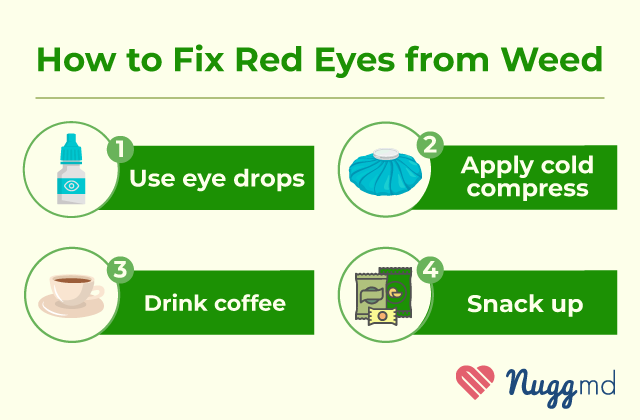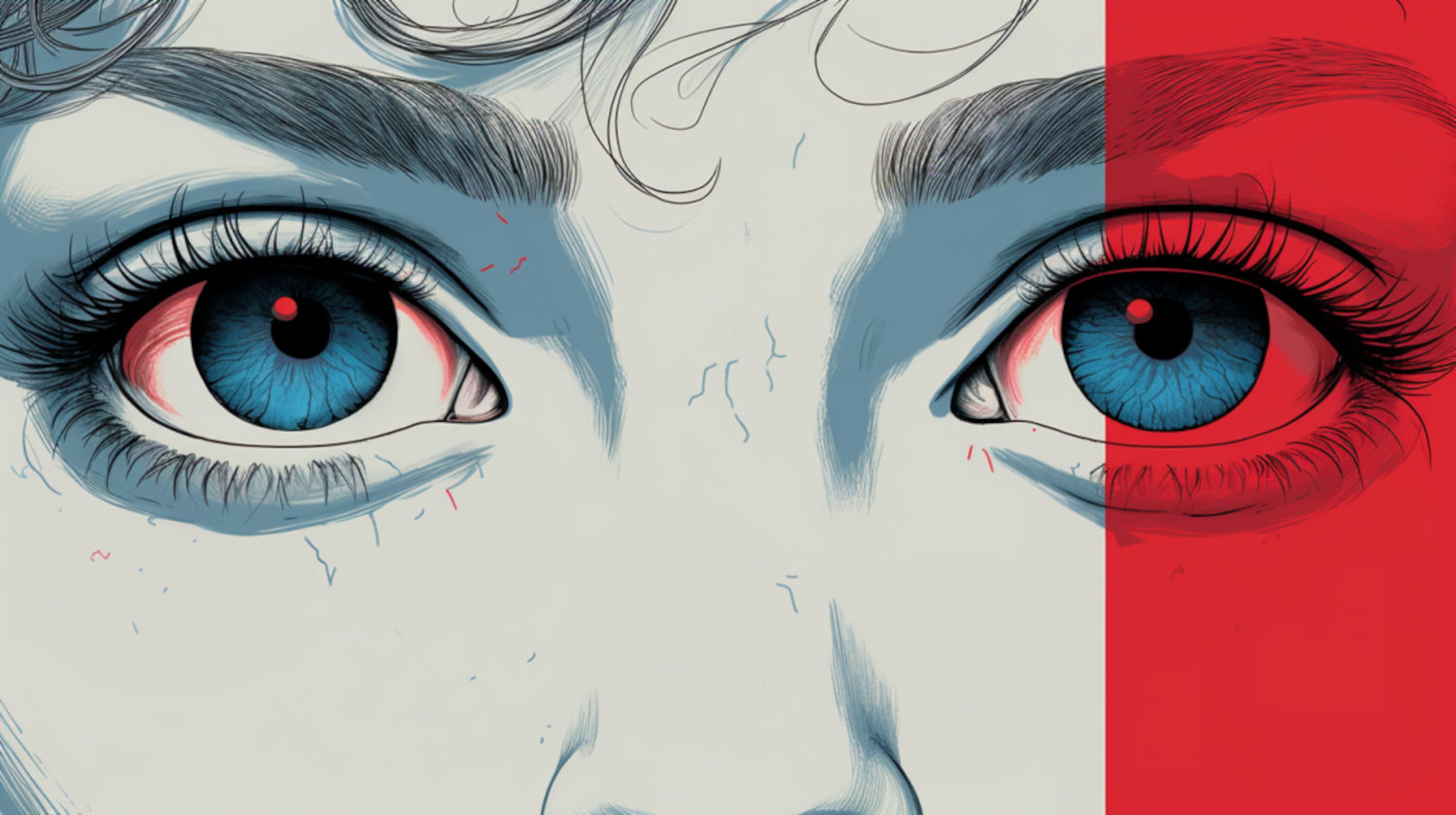In This Article
- Why Does Weed Make Your Eyes Red?
- How Long Do Red Eyes From Smoking Weed Last?
- Why Don't My Eyes Get Red When I'm High?
- 1. Individual Genetics and Sensitivity
- 2. Terpenes and Cannabis Varieties
- 3. High or Low Tolerance
- How to Get Rid of Red Eyes From Weed
- 1. Eye Drops
- 2. Artificial Tears
- 3. Stay Hydrated
- 4. Avoid Smoke Exposure
- 5. Apply a Cold Compress
- How to Prevent High Red Eyes
- 1. Choose the Right Strain
- 2. Adjust Your Dosage
- 3. Stay Hydrated
- 4. Use Eye Drops Proactively
- 5. Time Your Consumption
- 6. Avoid Products High in Terpenes Known to Irritate Eyes
- References
For many people, cannabis may produce several therapeutic and recreational benefits. Although it offers a form of peace and relaxation, it also brings along a distinctive trait – red, bloodshot eyes. "High eyes" can be a source of discomfort or embarrassment, often leading many to wonder how to get rid of stoned eyes fast. Thankfully, there are options to reduce or eliminate this potentially awkward side effect of cannabis.
Why Does Weed Make Your Eyes Red?
Cannabis smoke may not solely make eyes red. The cause is more complex and interesting than that.
One of the key contributors to red eyes after cannabis consumption is vasodilation, which refers to the widening of blood vessels. The cannabinoids in marijuana, notably tetrahydrocannabinol (THC), have a remarkable ability to induce vasodilation in the blood vessels within the eye. This process leads to increased blood flow, particularly to the eyes' conjunctiva – the clear membrane covering the white part of the eye and the inner surface of the eyelids. This is why medical cannabis is so beneficial for glaucoma patients.
This increase in blood flow is a direct consequence of THC's interaction with the endocannabinoid system, specifically the TRPA1 ion channel.1 An ion channel is a specialized protein structure embedded in the cell membrane that regulates the flow of ions (charged particles) in and out of a cell.
The connection to ion channels is important because the dilation of blood vessels involves the regulation of ion channels in the smooth muscle cells that line these vessels. Typically, these ion channels help control the contraction and relaxation of the muscle cells, thereby regulating the size of blood vessels.2
Beyond cannabinoids like THC, cannabis contains dozens of aromatic compounds called terpenes, which help contribute to the plant's distinctive scent and flavor.
Some terpenes found in cannabis strains, such as terpineol, carene, pinene, limonene, and butanol, have been identified as potential eye irritants. When inhaled, these terpenes can further exacerbate eye redness and irritation, compounding the effect caused by vasodilation.3
Cannabis smoke itself can be an irritant to the eyes. The particulate matter and combustion byproducts in cannabis smoke can lead to eye discomfort and redness, similar to the effects of exposure to other types of smoke.
Finally, you could be among those simply allergic to the plant. An allergic reaction could be the root of “high eyes.” However, other symptoms such as rashes, hives, or angioedema (swelling) would also likely be present if this was the case.
How Long Do Red Eyes From Smoking Weed Last?

Many cannabis consumers wonder, "How long will my red eyes last?"
The duration of red eyes after smoking weed varies from person to person. For some, the redness may dissipate relatively quickly. For others, it could linger for many hours. In most cases, red eyes from cannabis use is a short-term effect, typically lasting for a few hours at most. As the effects of cannabis gradually wear off, eyes should return to their normal appearance.
Several factors can influence how long red eyes last after smoking weed:
- THC Content: Strains with higher THC content are more likely to induce longer-lasting redness.
- Dosage: The amount of cannabis consumed plays a significant role. Higher doses can lead to more pronounced and prolonged red eyes.
- Tolerance: Regular cannabis consumers may develop a tolerance to the vasodilatory effects of THC, potentially reducing the duration of redness over time.
- Individual Sensitivity: Individual sensitivity to cannabis compounds and terpenes can also influence how long redness lasts.
While high red eyes can be a visible indicator of cannabis consumption, they are generally harmless and temporary. If red eyes are a persistent issue or cause discomfort, consider adjusting your cannabis consumption method, strain choice, or dosage to minimize this side effect.4
Why Don't My Eyes Get Red When I'm High?
Sometimes, eyes don't turn red after consuming cannabis. While not necessarily the norm, there are several reasons why some people may not experience this particular side effect.
1. Individual Genetics and Sensitivity
One of the primary reasons why some people don't get red eyes when they're high is because of their individual physiology. Our bodies respond differently to various substances, including cannabinoids and terpenes found in cannabis. Genetics can play a significant role in determining how the body reacts to these compounds.
So, some people may simply have a genetic predisposition that makes them less sensitive to the vasodilatory effects of THC, resulting in minimal or no redness in the eyes.
2. Terpenes and Cannabis Varieties
The choice of cannabis strain can also influence whether a person's eyes turn red or not. Certain terpenes found in cannabis strains, such as terpineol, carene, pinene, limonene, and butanol, are known to be eye irritants. These terpenes may contribute to the bloodshot eyes experienced by some cannabis users. Selecting a strain with lower concentrations of these irritant terpenes may reduce the likelihood of red eyes.
3. High or Low Tolerance
Regular cannabis users often develop tolerance to some of its effects, which may potentially include the vasodilation that causes red eyes. Over time, the body may become less responsive to THC's effects on blood vessels, which can result in reduced redness.
How to Get Rid of Red Eyes From Weed

Red eyes after enjoying the therapeutic effects of cannabis can be a noticeable and sometimes inconvenient side effect. Fortunately, there are several natural remedies and strategies to alleviate high red eyes and restore a sober appearance quickly.
Here's how to get rid of “high eyes”:
1. Eye Drops
Eye drops are specifically designed to relieve redness and soothe eye irritation and are a quick and effective remedy for red eyes caused by cannabis. These over-the-counter products, often referred to as "redness relief" or "eye whitening" drops, work by constricting the blood vessels in the eyes, reducing redness.
2. Artificial Tears
Cannabis use can sometimes lead to dry eyes, which can exacerbate redness. Artificial tears, available without a prescription at most drugstores, can help alleviate dryness and provide relief from red eyes. These eye drops lubricate the eyes, reducing irritation and redness.
3. Stay Hydrated
Dehydration can contribute to eye redness. Staying well-hydrated can help combat this. Drinking plenty of water can help maintain eye moisture and reduce the severity of red eyes.
4. Avoid Smoke Exposure
If cannabis smoke irritates your eyes, consider alternative consumption methods such as vaping, edibles, or tinctures. These methods can provide the desired effects of cannabis without the potential eye irritation caused by smoke.
5. Apply a Cold Compress
A cold compress can help constrict blood vessels and reduce eye redness. Simply soak a clean cloth in cold water, wring it out, close your eyes, and place it over your eyes for a few minutes.
The speed at which these remedies work can vary depending on the severity of your red eyes and the specific remedy used. Eye drops designed to relieve redness often provide rapid results, with redness diminishing within minutes. Cold compresses and artificial tears may take slightly longer, but you can generally expect to see improvements within 15-30 minutes.
How to Prevent High Red Eyes
Preventing red eyes when using cannabis can help maintain a discreet and inconspicuous appearance, especially in a social or professional setting. While red eyes may be somewhat unavoidable, there are some strategies to prevent high red eyes while using cannabis.
1. Choose the Right Strain
Different cannabis strains have varying levels of cannabinoids and terpenes, which can influence the likelihood of red eyes. Strains that are high in THC are more likely to cause redness. Choosing strains with lower THC content or those with a more balanced THC-to-CBD ratio may reduce the likelihood of red eyes. CBD, a non-intoxicating cannabinoid, may have different effects on blood vessels and may not induce the same level of vasodilation as THC.5
2. Adjust Your Dosage
Red eyes can be dose-dependent. Lowering your cannabis dosage can reduce the chances of experiencing redness. Start with a lower dose and gradually increase it until the desired effect is achieved without excessive redness.
3. Stay Hydrated
Dehydration can exacerbate red eyes. Drinking plenty of water before and during a cannabis session can help maintain eye moisture and reduce the severity of red eyes.
4. Use Eye Drops Proactively
Applying lubricating eye drops or artificial tears before consuming cannabis can help prevent or reduce red eyes. These drops can keep your eyes moist and reduce the likelihood of irritation.
5. Time Your Consumption
If you have social or professional commitments, plan your cannabis consumption accordingly. Consider using cannabis during times when you can sit back and relax without needing to worry about red eyes. Allow for the effects to subside before engaging in activities that require a clear-eyed appearance.
6. Avoid Products High in Terpenes Known to Irritate Eyes
Some terpenes found in cannabis strains, such as terpineol, carene, pinene, limonene, and butanol, are known to be eye irritants. Be cautious with strains particularly high in these terpenes when trying to prevent “high eyes.”
References
- Montecucco F, Di Marzo V. At the heart of the matter: the endocannabinoid system in cardiovascular function and dysfunction. Trends in Pharmacological Sciences. 2012;33(6):331-340. doi:https://doi.org/10.1016/j.tips.2012.03.002 ↩︎
- Thorneloe KS, Nelson MT. Ion channels in smooth muscle: regulators of intracellular calcium and contractility. Canadian Journal of Physiology and Pharmacology. 2005;83(3):215-242. doi:https://doi.org/10.1139/y05-016 ↩︎
- MØLHAVE L, KJAERGAARD SK, HEMPEL-JØRGENSEN A, et al. The Eye Irritation and Odor Potencies of Four Terpenes which are Major Constituents of the Emissions of VOCs from Nordic Soft Woods. Indoor Air. 2000;10(4):315-318. doi:https://doi.org/10.1034/j.1600-0668.2000.010004315.x ↩︎
- MacCallum CA, Russo EB. Practical considerations in medical cannabis administration and dosing. European Journal of Internal Medicine. 2018;49(49):12-19. doi:https://doi.org/10.1016/j.ejim.2018.01.004 ↩︎
- Kicman A, Toczek M. The Effects of Cannabidiol, a Non-Intoxicating Compound of Cannabis, on the Cardiovascular System in Health and Disease. International Journal of Molecular Sciences. 2020;21(18):6740. doi:https://doi.org/10.3390/ijms21186740 ↩︎
The information in this article and any included images or charts are for educational purposes only. This information is neither a substitute for, nor does it replace, professional legal advice or medical advice, diagnosis, or treatment. If you have any concerns or questions about laws, regulations, or your health, you should always consult with an attorney, physician or other licensed professional.




